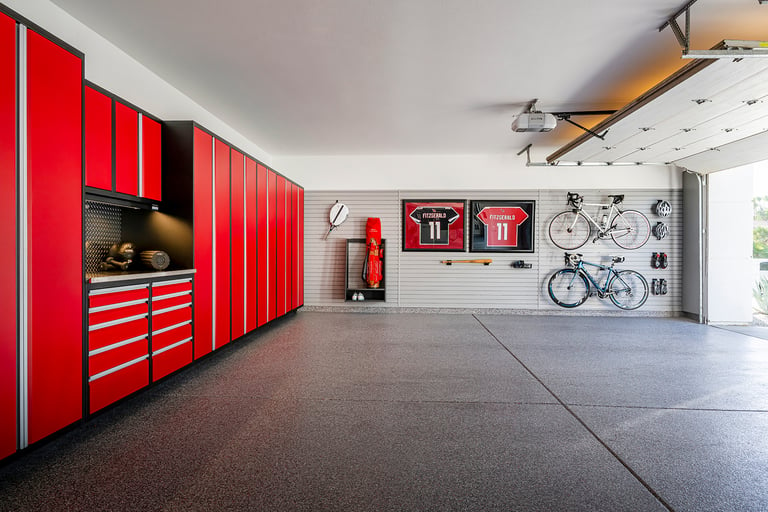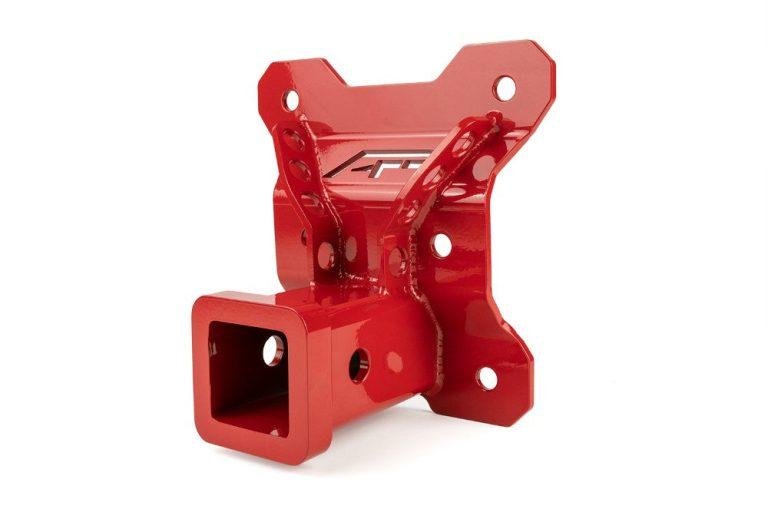A garage floor for a lift should be at least 4 inches thick to ensure proper functionality and safety. Garage floor thickness for a lift is crucial to ensure proper stability and support.
To accommodate the weight and pressure exerted by the lift, it is recommended to have a floor thickness of at least 4 inches. This thickness provides the necessary strength to prevent cracking or sagging, ensuring the lift operates smoothly and securely.
Furthermore, a thicker garage floor minimizes the risk of damage to the floor structure over time, ensuring long-lasting performance and durability. By adhering to these guidelines, you can guarantee a reliable and safe lift installation in your garage.

Credit: www.garageliving.com
Understanding The Importance Of Floor Thickness In Lifting Equipment
Understanding the importance of floor thickness in lifting equipment is crucial when determining how thick a garage floor should be for a lift. By ensuring the floor is sturdy enough to support the weight and pressure of the lift, you can prevent damage to both the equipment and the floor, ensuring safety and functionality.
Lifting equipment such as car lifts are essential tools in any garage, providing easy access to work on vehicles from underneath. However, it’s crucial to understand the significance of having a sturdy foundation for such equipment. One key factor to consider is the thickness of the garage floor.
Let’s delve into why a properly thickened floor is vital for lifting equipment and explore important factors to consider:
Importance Of A Sturdy Foundation For Lifting Equipment:
- Stability: A thick garage floor enhances the stability of lifting equipment, ensuring it remains steady and secure during use. This prevents any unwanted movements that could compromise safety.
- Weight distribution: Lifting equipment exerts a considerable amount of weight and force on the floor. With a robust foundation, the weight is distributed evenly, reducing the risk of cracks or damage.
- Durability: A thick floor is more resilient to the heavy loads applied by lifting equipment, allowing it to withstand prolonged use without wearing down.
- Safety: By ensuring the garage floor can support the weight and force generated by lifting equipment, you minimize the chances of accidents or structural failures that could result in injury.
Factors To Consider When Determining Floor Thickness For A Lift:
- Lift type and capacity: Different types of lifts have varying weight capacities. The type of lift you plan to use in your garage will dictate the required floor thickness to safely support its load.
- Garage floor material: The material of the garage floor, such as concrete or epoxy, can affect the necessary thickness for a lift. Each material has its own load-bearing capabilities.
- Subfloor conditions: The condition of the subfloor beneath the garage floor is crucial. Uneven or weak subfloors may require additional thickness to ensure stability and prevent structural issues.
- Local building codes: It’s essential to consult local building codes and regulations when determining the minimum floor thickness required for lifting equipment. Compliance with these codes ensures safety and avoids potential legal issues.
The thickness of your garage floor plays a significant role in the stability, safety, and durability of lifting equipment. By understanding the importance of floor thickness and considering factors such as lift type, garage floor material, subfloor conditions, and local building codes, you can ensure a sturdy foundation for your lifts, providing a secure workspace for automotive maintenance and repairs.
Expert Recommendations For Garage Floor Thickness
Expert recommendations for garage floor thickness are essential when considering the installation of a lift. The ideal thickness for a garage floor to accommodate a lift is generally around 4 to 6 inches, providing the necessary strength and stability for heavy machinery.
Having the appropriate floor thickness ensures a safe and functional space for your garage lift needs.
When installing a lift in your garage, it is crucial to consider the thickness of your garage floor to ensure stability and safety. Expert recommendations can help determine the optimal floor thickness for your specific lift requirements. Here are some factors to consider and the recommended thickness range based on the type and weight capacity of the lift:
Plain Paragraph:
- The thickness of the garage floor depends on the type of lift you plan to install.
- For standard two-post lifts with a weight capacity between 7,000 and 10,000 pounds, the recommended minimum thickness is 4 inches.
- However, for heavier-duty lifts with weight capacities exceeding 10,000 pounds, the floor thickness should be increased to 6 inches or more to ensure adequate support.
Recommended Thickness Range Based On The Type And Weight Capacity Of The Lift:
- For 7,000 to 10,000-pound lifts: 4 inches
- For lifts over 10,000 pounds: 6 inches or more
Factors That May Require Additional Floor Thickness For A Lift Installation:
- Soil conditions: If your garage is built on unstable or unsettled soil, it is advisable to increase the floor thickness to provide better support.
- Vehicle weight and size: Larger vehicles will place more stress on the lift and the garage floor, so increasing the thickness is necessary to accommodate the additional load.
- Frequency of lift use: If you plan to use the lift frequently or for heavy-duty applications, a thicker floor will enhance durability and stability.
Remember, these recommendations serve as general guidelines. It is always recommended to consult with a professional before installing a lift to ensure that all specific factors are considered. By keeping these expert recommendations in mind, you can ensure the proper thickness of your garage floor for a lift installation, providing a safe and durable foundation for your lifting needs.
Assessing Existing Garage Floor Thickness
Garage floor thickness should be assessed carefully to determine if it can support a lift. The appropriate thickness varies depending on the weight of the lift and the load it will bear, but generally, a minimum of 4 inches is recommended for residential garages.
If you’re planning to install a car lift in your garage, one crucial factor to consider is the thickness of your garage floor. A garage floor needs to be strong enough to support the weight of both the lift and the vehicle that will be elevated.
In this section, we will discuss the steps to measure the current thickness of your garage floor, evaluate whether your existing floor can support a lift, and explore options for reinforcing a thinner garage floor for lift installation.
Steps To Measure The Current Thickness Of Your Garage Floor:
- First, clear out any items or debris from your garage floor to get a clear view of its surface.
- Use a tape measure or ruler to determine the thickness of the floor. Measure from the top surface to the bottom surface, excluding any surface coatings or finishes.
- Measure at multiple points across the floor to get an accurate average thickness. Record these measurements for future reference.
Evaluating Whether Your Existing Floor Can Support A Lift:
- Check the manufacturer’s specifications for the lift you intend to install. They will usually provide a minimum required floor thickness for safe installation.
- Compare the average thickness of your garage floor with the manufacturer’s recommendations. If your floor falls below the specified thickness, further evaluation is necessary to determine its structural integrity.
Options For Reinforcing A Thinner Garage Floor For Lift Installation:
- Consult with a structural engineer or a professional contractor who specializes in garage floor reinforcements. They can assess your floor and recommend appropriate reinforcement methods.
- One option is to add a layer of concrete to increase the thickness of the floor. This involves removing any existing coatings or finishes and pouring additional concrete on top.
- Another option is to reinforce the existing floor with steel plates or beams. These additions can help distribute the load more evenly, making a thinner floor capable of supporting a lift.
- If your garage is built on a concrete slab, it may be necessary to reinforce the base foundation before reinforcing the floor itself. A professional can help determine the best course of action in such cases.
Remember, ensuring the proper thickness and structural integrity of your garage floor is crucial for the safe installation and operation of a car lift. By following the steps to assess your floor’s thickness and exploring suitable reinforcement options, you can confidently proceed with your lift installation plans.
Pouring A New Garage Floor For A Lift
When installing a lift in your garage, it is crucial to consider the thickness of the floor to ensure stability and durability. The ideal thickness for a garage floor with a lift is typically 6 inches, providing enough strength to support the weight and pressure of the lift.
Proper planning and consultation with a professional can help ensure a safe and secure installation.
Are you thinking about installing a lift in your garage? One of the most important considerations is the thickness of the garage floor. A proper garage floor thickness is crucial to ensure durability and load-bearing capacity. In this section, we will discuss the steps to pour a new garage floor that meets the necessary thickness requirements for a lift.
Additionally, we will explore the factors to consider when choosing materials and whether to hire a professional or do it yourself.
Steps To Pour A New Garage Floor To Meet The Necessary Thickness Requirements For A Lift:
- Start by preparing the surface: Clear the garage area and remove any existing flooring materials. Ensure that the surface is clean, level, and free from debris. Proper preparation is essential to achieve a smooth and sturdy garage floor.
- Determine the required thickness: Check the manufacturer’s specifications for the lift you plan to install. This will help you determine the minimum thickness required for your garage floor. Generally, a thickness of at least 4 inches is recommended for residential garage floors with lifts.
- Excavate the area: Use a shovel or excavator to dig out the area where the new garage floor will be poured. The depth of the excavation should match the required thickness of the floor. Make sure to remove any soil or rocks that may hinder the proper placement of the concrete.
- Install a vapor barrier: To prevent moisture from seeping through the floor, it is important to install a vapor barrier. This helps protect the concrete and prolong its lifespan. Lay down a plastic sheet or vapor barrier material and ensure it covers the entire excavation area.
- Place reinforcement: Adding reinforcement helps strengthen the garage floor and increase its load-bearing capacity. Install steel rebar or wire mesh within the excavation area, ensuring it is evenly distributed and raised off the ground to provide proper support.
- Pour the concrete: Once all preparations are complete, it’s time to pour the concrete. Mix the concrete according to the manufacturer’s instructions, and pour it into the excavation area. Use a screed board or a bull float to level the surface and eliminate any excess concrete.
- Smooth and finish the surface: After pouring the concrete, use a float or trowel to smooth the surface and create a uniform texture. This step helps improve the overall appearance of the garage floor and ensures it is ready for the installation of a lift.
- Allow curing time: Concrete takes time to cure and reach its maximum strength. It is important to follow the manufacturer’s recommendations for curing time. This typically involves covering the newly poured concrete with a curing compound or wetting it periodically to prevent drying too quickly.
- Test the floor’s strength: Once the curing process is complete, it is advisable to conduct a load test to ensure the floor can withstand the weight of the lift and vehicles. Consult with professionals or reference industry guidelines to perform a proper load test.
- Install the lift: Finally, when the garage floor has fully cured and passed the load test, you can proceed with the installation of the lift. Ensure that the lift is securely anchored to the concrete floor according to the manufacturer’s instructions.
Choosing The Right Materials For Durability And Load-Bearing Capacity:
- Quality concrete mix: Opt for a high-quality concrete mix that is specifically designed for garage floors and has excellent compressive strength.
- Reinforcing materials: Consider using steel rebar or wire mesh to reinforce the concrete and enhance its load-bearing capacity.
- Vapor barrier: Choose a durable vapor barrier material that is resistant to moisture and can effectively prevent moisture seepage.
- Curing compound: Select a reliable curing compound that helps the concrete cure evenly and maintain its strength over time.
Hiring A Professional Or Doing It Yourself – Pros And Cons:
Hiring a professional:
- Pros:
- Expertise and experience: Professionals have the necessary knowledge and experience to ensure a proper and efficient installation, minimizing the risk of mistakes.
- Time-saving: Hiring professionals saves you time and effort as they will handle all aspects of the project, from preparation to pouring and finishing.
- Guarantees and warranties: Reputable professionals offer guarantees and warranties for their work, providing peace of mind.
- Cons:
- Cost: Hiring professionals can be more expensive as you will be paying for their labor and expertise.
- Scheduling constraints: You may need to align your project with the availability of the professionals, which can sometimes cause delays.
Doing it yourself:
- Pros:
- Cost-saving: By doing it yourself, you can save on labor costs, which can be significant.
- Flexibility: Diy projects allow you to work at your own pace and on your own schedule.
- Sense of achievement: Completing a diy project can be rewarding and give you a sense of accomplishment.
- Cons:
- Skill and knowledge requirements: Diy garage floor pouring requires a certain level of skill and knowledge, and mistakes can be costly to fix.
- Time-consuming: Diy projects can take longer to complete, especially if you are not experienced in the process.
- Risk of improper installation: If not done correctly, an improperly poured garage floor can lead to structural issues and compromise the safety of the lift.
Remember, whether you choose to hire a professional or do it yourself, the thickness and quality of your garage floor are paramount when installing a lift. By following the necessary steps and using the right materials, you can ensure a durable and safe foundation for your lift system.
Reinforcing An Existing Garage Floor For Lift Installation
Reinforcing an existing garage floor is crucial for the proper installation of a lift. The ideal thickness for a garage floor to support a lift depends on the weight capacity and type of lift being installed. Professional consultation is recommended to determine the appropriate thickness to ensure safety and stability.
Methods For Reinforcing An Existing Garage Floor To Support A Lift:
To ensure the safety and structural integrity of an existing garage floor for lift installation, several methods can be employed. Here are some effective ways to reinforce your garage floor:
- Steel plates: One method to increase the floor thickness and load-bearing capacity is by using steel plates. These plates are inserted into the concrete, providing additional strength and stability. Steel plates are especially useful for older garage floors that may not meet the necessary requirements to support a lift.
- Epoxy coatings: Another option is to apply epoxy coatings to the floor surface. Epoxy coatings are strong, durable, and capable of increasing the floor’s thickness. This method also enhances the floor’s resistance to chemicals, stains, and impact, ensuring better protection against wear and tear.
Considerations for structural integrity and safety when reinforcing an existing floor:
- Professional assessment: Before reinforcing an existing garage floor, it is crucial to seek the advice of a professional engineer or contractor. They can evaluate the current floor condition, identify any weaknesses or potential issues, and recommend suitable reinforcement solutions.
- Weight capacity: When reinforcing a garage floor for a lift, it is essential to consider the weight capacity of both the lift and the vehicles it will be supporting. The reinforcement method chosen should be able to handle the combined weight without compromising the floor’s structural integrity.
- Structural modifications: Depending on the existing floor’s condition and the chosen reinforcement method, structural modifications may be required. These modifications could include installing additional support beams or columns to distribute the load evenly and provide added strength.
- Sustainability and longevity: When selecting a reinforcement method, consider options that offer long-term sustainability and durability. Investing in high-quality materials and professional installation ensures that your reinforced garage floor can withstand heavy loads and maintain its integrity over time.
- Safety measures: Reinforcing a garage floor for a lift installation is not just about the floor’s strength; it is also about ensuring the safety of those using the lift. Additional safety measures, such as non-slip coatings or anti-vibration pads, should be considered to prevent accidents and maintain a secure working environment.
By following these methods and considerations, you can reinforce your existing garage floor to support a lift installation adequately. Prioritize safety and structural integrity to create a reliable and durable workspace for your vehicle maintenance needs.
Maintaining And Repairing A Garage Floor With A Lift
Maintaining and repairing a garage floor with a lift requires a certain thickness to ensure stability and longevity. The recommended thickness for a garage floor with a lift is typically around 4 to 6 inches, providing the necessary support for heavy equipment and vehicles.
Properly analyzing the specific lift and its weight capacity is essential to determine the ideal thickness for your garage floor.
A garage floor is a crucial component when it comes to installing a lift. Ensuring the structural integrity of your garage floor is imperative for both the safety of your lift and the longevity of your floor. In this section, we will delve into best practices for maintaining the structural integrity of your garage floor, as well as identifying and addressing common issues such as cracks and uneven surfaces.
We will also discuss the importance of regular inspections and maintenance to ensure the safety of your lift and floor.
Best Practices For Maintaining The Structural Integrity Of Your Garage Floor:
- Regular cleaning: Keeping your garage floor clean from dirt, debris, and chemicals will help prevent any damage that can compromise its structural integrity. Sweep or use a leaf blower to remove loose substances regularly.
- Avoid heavy impact: To prevent cracks and other forms of damage, it is essential to avoid dropping heavy objects or applying excessive pressure on the floor.
- Minimize exposure to moisture: Moisture can seep into the concrete, leading to cracks and weakening the floor’s structure. Take preventive measures to minimize moisture exposure, such as sealing the concrete and addressing any water leaks promptly.
- Use floor mats: Placing floor mats in areas where there is excessive foot or vehicle traffic can help protect the floor from wear and tear. Look for mats specifically designed for garage floors that are resistant to chemicals, oil, and other substances.
Identifying And Addressing Common Issues Such As Cracks And Uneven Surfaces:
- Cracks: Inspect your garage floor regularly for any signs of cracks. If you notice small cracks, these can be filled with a concrete repair product. However, larger cracks may require professional intervention to ensure proper repair.
- Uneven surfaces: Uneven surfaces can create safety hazards for both your lift and yourself. If you identify any uneven areas on your garage floor, you can consider leveling the floor or adding a self-leveling compound to address the issue.
- Repairing damaged areas: Any damaged areas on your garage floor should be repaired promptly. Small chips or holes can be filled using epoxy patching compound, while larger areas of damage may require professional assistance.
Regular Inspections And Maintenance To Ensure The Safety Of Your Lift And Floor:
- Visual inspections: Regularly inspect your garage floor for signs of wear, cracks, or damage. Look out for changes in the surface or any other issues that may affect the safety of your lift and floor.
- Lubrication and maintenance: Follow the manufacturer’s guidelines to ensure regular lubrication and maintenance of your lift. This will help prevent unnecessary strain on the garage floor and maintain the lift’s performance.
- Professional assistance: If you are unsure about any aspect of maintaining or repairing your garage floor, it is always advisable to seek professional assistance. They can provide expert advice and carry out necessary repairs or maintenance procedures.
By adhering to these best practices and conducting regular inspections and maintenance, you can ensure the safety of both your garage floor and the lift installed within it. Taking the necessary steps to maintain and repair your garage floor will not only increase its lifespan but also contribute to the overall functionality and safety of your lift.
Frequently Asked Questions Of How Thick Should A Garage Floor Be For A Lift?
How Thick Concrete For 10,000 Lb Lift?
For a 10,000 lb lift, the concrete thickness should be at least 4 inches. The weight of the lift determines the required thickness to ensure the concrete can safely bear the load. A 4-inch thick concrete slab provides enough strength to support the 10,000 lb lift without cracking or breaking.
It is important to use high-quality concrete, properly mixed and compacted to achieve the required strength. Reinforcement with steel bars or fibers may also be necessary for added support, depending on the specific application and conditions. Regular inspections and maintenance are essential to ensure the integrity of the concrete slab and the safety of the lift operations.
How Thick Is The Cement For A 2-Post Lift?
The cement for a 2-post lift should be at least 4 inches thick. A 4-inch thick cement foundation provides the stability and strength necessary to support the weight of the lift and the vehicles it will hold. This thickness ensures that the cement can withstand the pressure and vibrations that occur during lifting and lowering operations.
A thicker foundation may be required based on the specific design and weight capacity of the lift. It is important to consult the manufacturer’s guidelines and local building codes to determine the exact thickness required for your particular 2-post lift installation.
Following these recommendations will ensure a solid and safe foundation for your lift, promoting efficient operation and minimizing the risk of accidents or damage.
What Size Garage Do I Need For A 2-Post Lift?
A 2-post lift requires a garage with a minimum height of 12ft and a width of at least 10ft. The depth of the garage should be sufficient for the overall length of the vehicle you plan to lift. It is also important to consider additional space for maneuvering around the lift and working comfortably.
Consulting the manufacturer’s specifications is crucial to ensure proper installation and safety. Prior to installing a 2-post lift, it is recommended to have a professional evaluate your garage and determine if any modifications are required.
How Thick Does A Concrete Slab Have To Be To Hold A Car?
A concrete slab needs to be at least 4 inches thick to support the weight of a car.
Conclusion
Choosing the right thickness for your garage floor when installing a lift is crucial for both safety and functionality. It is recommended to consult with a professional who can assess the specific requirements of your lift and garage space. As a general guideline, a minimum thickness of 4 inches is typically sufficient for most residential garage lifts, while commercial or heavier lifts may require a thicker slab.
Reinforcing the concrete with steel rebar or wire mesh can also enhance its strength and durability. Furthermore, proper curing and moisture protection measures should be taken to prevent cracks or structural damage over time. By ensuring the garage floor is thick enough to support the weight of the lift and vehicles, you can enjoy hassle-free maintenance and operations while keeping your garage safe and structurally sound.






